
未接受“ BafA”的小鼠血管细胞(左)和产生许多新血管的细胞(藤田医学院提供)。

藤田医科大学:发现构成血管,细菌的物质:用于再生医学
藤田医科大学和大阪大学:
这种细菌感染人类时会引起发烧。
在细菌“巴尔通体”中,我发现“一种可以增加人体血管的蛋白质”。
藤田医科大学和大阪大学团队于7月16日在英文科学杂志上宣布。
“产生血管的物质”:
藤田医科大学的冢本讲师发现了一种“会产生血管的物质”与细菌。
为了在再生医学制成的器官周围拉伸血管,
它可以用于治疗心肌梗塞。
细菌“巴尔通体”:
巴尔通体引起“猫抓病”,引起发烧和淋巴结肿大。
当没有免疫力的人被感染时,血管细胞的数量异常增加。
传统上,人们认为Bartonella会分泌增加血管中细胞数量的物质,但实际身份尚不清楚。
联合沟通
https://this.kiji.is/656437001134408801
The Bartonella autotransporter BafA activates the host VEGF pathway to drive angiogenesis
Published: 16 July 2020
Kentaro Tsukamoto, Naoaki Shinzawa, […]Yohei Doi
Nature Communications volume 11, Article number: 3571 (2020) Cite this article
Metrics detailsNature Communications
Abstract
Pathogenic bacteria of the genus Bartonella
can induce vasoproliferative lesions during infection.
The underlying mechanisms
are unclear, but involve secretion of an unidentified mitogenic factor.
Here, we use functional transposon-mutant screening in Bartonella henselae to identify such factor as a pro-angiogenic autotransporter, called BafA.
The passenger domain of BafA
induces cell proliferation, tube formation and sprouting of microvessels, and drives angiogenesis in mice.
BafA
interacts with vascular endothelial growth factor (VEGF) receptor-2 and activates the downstream signaling pathway, suggesting that BafA functions as a VEGF analog.
A BafA homolog from a related pathogen, Bartonella quintana, is also functional. Our work unveils the mechanistic basis of vasoproliferative lesions observed in bartonellosis,
and we propose BafA as a key pathogenic factor contributing to bacterial spread and host adaptation.